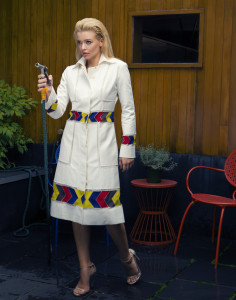 Here is the dream: I step out into the glimmering light after the last model has left the runway and the debut of my apparel line at New York Fashion Week has officially come to a close. I am met with a standing ovation and cheers from the countless beautiful and influential faces in the crowd. I can feel the excitement and prowess of my success.
Here is the dream: I step out into the glimmering light after the last model has left the runway and the debut of my apparel line at New York Fashion Week has officially come to a close. I am met with a standing ovation and cheers from the countless beautiful and influential faces in the crowd. I can feel the excitement and prowess of my success.
Easy dream. Right?
Here is the problem with this dream: I had no clue what it would take to become a fashion designer. I didn’t go to school for fashion design. I went to school for business. I knew very little about production, sourcing and competition (oy vey, the fierce competition of the fashion industry), and even more importantly the network.
However, what I did know, and have always known, is that I loved fashion. I loved the confidence clothing can exude when you put on something unique and gorgeous. I knew I wanted to design and I loved branding, so I started designing clothing.
Now, eight years and several out-of-pocket investments later, some minor successes, a lot of failure, and a major forthcoming pivot from my original brand, Christiana J. Paul, I am taking all the pins (successes) and needles (failures) of my first entrepreneurial journey and applying them to the next adventure.
Here are 10 of my top key lessons on being a designer and owning a brand outside of the most important 4P’s (product, price, positioning, and promotion), which can be applied to any entrepreneur or company:
- Begin somewhere: To find success you must begin somewhere. You must go from 0 to 1. Idleness is not an option. Beginning is the most important part of the journey, which will assist in the navigation of the path to finding your own success and what it takes to win.
- Build a micro plan first: Start small, be creative, and then scale. Sell one, then sell two, then sell a dozen. Don’t believe that you need to compete with the big players from day one, that will come in time when your product is in demand. (Key point: create demand.)
- Pivot, then pivot again: Being objective, flexible, and disciplined is critical. Sometimes this means starting all over, and other times it means revising the original plan. Being fixated on an idea can lead to more scrutiny than success. The need to pivot is essential to morphing a product from good to great. Always ask, “How can we think about this differently?”
- Be consumer-centric: Finding consumer solutions is the goldmine to success, and for the most part, these goldmines do not currently exist. Consumer solutions are the nucleus of a great design. This part of the process is often met with painstaking ideation, time, and endless hours of research. However, this will be the most worthwhile time spent to answer the essential questions: “Will it work?” and “Will it sell?”
- Create a story (that people LOVE to talk about): There is nothing more fulfilling than consumers telling a great story about your product. In today’s content-driven society, stories are the #1 ingredient to connecting with consumers. As consumers are becoming more conscious of their purchasing decisions, when they find a product that provides them with a story to talk about and share, you will expand your connection and reach. Be creative. Be original. Be authentic.
- Do not serve two masters: Having a job while starting a company offers many benefits like health care, salary, and more, however, the more time you take away from your own company, the more you lose sales, focus, relationships, and many other entrepreneur benefits that will keep your company heading in the right direction. Determine what is a better sacrifice to your success.
- Live by your P&L: There is that saying “it takes money to make money,” and this is a very true statement, however, setting financial boundaries will set you up for success. Overextending your capital investment will shorten your lifespan and derail the future. Be creative in how you will leverage your funding, and find as many free or negotiated assets as possible (e.g., interns, content creators, material, etc.)
- Solidify and expand your network: The entire world operates on relationships. This important foundation has not changed even with the virtual and online world we now live in. Whether it is with a consumer, business partner, or interested party, people are seeking relationships that are real and authentic.
- Have confidence: Stand by your product. Believe in it. The more you believe in it, the more people will believe in you. Confidence will help you in everything that you do from design, sales, and marketing to enticing investors. In all industries, especially the fashion industry, without confidence you will not go very far.
- Do not give up: The importance of this is pivotal to success. It may take longer than you expected. You will have many pitfalls and people saying no. It may take an entire revision of plans, even letting go of one brand, only to create another (see point #3), or sacrificing in more ways than you expected. However, if you love what you do and are determined, you will find the path to success.
 My dream of being a fashion designer and owning a successful fashion label is still as real and vivid from the day I started to today. However, instead of it being a dream, from all the lessons I learned, it is a strategic and well thought out path for my own success story.
My dream of being a fashion designer and owning a successful fashion label is still as real and vivid from the day I started to today. However, instead of it being a dream, from all the lessons I learned, it is a strategic and well thought out path for my own success story.

